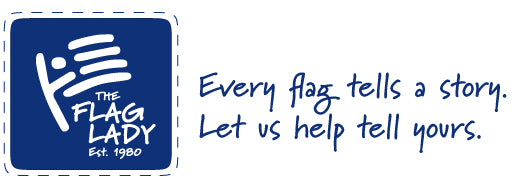Understanding the Difference Between Single-Sided, Double-Sided, and Single Reverse Flags
When shopping for a flag, one of the most common—and most confusing—decisions is whether to choose single-sided, double-sided, or single reverse. Each option serves a different purpose and affects how the flag looks, flies, and lasts. Here’s a quick breakdown to help you decide which type is best for your needs.
1. Single Reverse Flags (Most Common Style)
What It Means:
Single reverse flags are printed on one side of the fabric, and the design bleeds through to the back side in reverse (a mirror image). This is the standard style that we print.

Pros:
-
Lightweight and flies more freely in the wind.
-
Cost-effective and durable for most outdoor conditions.
-
Colors remain vibrant even with the reverse print.
Best For:
-
Residential & Commercial flagpoles
-
Outdoor use where the flag will move with the wind
-
Most U.S. flags and state flags you see flying on poles
Example:
If your flag says “Welcome,” the front side will read correctly, while the back side will show “emocleW” in reverse.
2. Double-Sided Flags (Two-Ply Construction)
What It Means:
Double-sided flags are made by printing or sewing two flags together, with a liner in between to prevent show-through. Both sides read correctly. We can do double sided by printing two flags, adding a mid-liner, and sewing them back-to-back.

Pros:
-
Messaging is legible from both sides (perfect for text or detailed designs).
-
Looks premium and is often used in ceremonial or commercial displays.
Cons:
-
Heavier, requiring stronger wind to fly.
-
Typically more expensive due to added materials and labor.
-
Shorter lifespan outdoors compared to single reverse due to added weight and wind stress.
Best For:
-
Flags with words or logos that must be readable from both directions
-
Indoor or low-wind settings
-
High-visibility promotional flags or banners
3. Single-Sided Flags
What It Means:
Sometimes used interchangeably with “single reverse,” but technically refers to flags that are printed on one side only and may not show through at all, depending on the fabric and ink. We can do single-sided flags for you, but we don't print this way normally.

Pros:
-
Ideal for wall-hanging or indoor displays where only one side is visible.
-
Can offer more vivid colors on one side, without the concern of reverse bleed-through.
Cons:
-
Back side may appear blank or significantly faded.
Best For:
-
Wall décor
-
Parade banners
-
Short-term event use
Which Should You Choose?
-
Go with single reverse for most outdoor residential and patriotic flags—lightweight, cost-effective, and durable.
-
Choose double-sided for commercial flags with text, logos, or directional signs where both sides need to be read correctly.
-
Pick single-sided when mounting flags flat against a wall or indoors where only one side will ever be seen.
Final Tip:
Always ask your flag provider to clarify how the flag is constructed—especially if you're ordering a custom design or logo flag. At Flag Lady USA, we offer all three options depending on your needs and are happy to guide you toward the best choice for your display.

